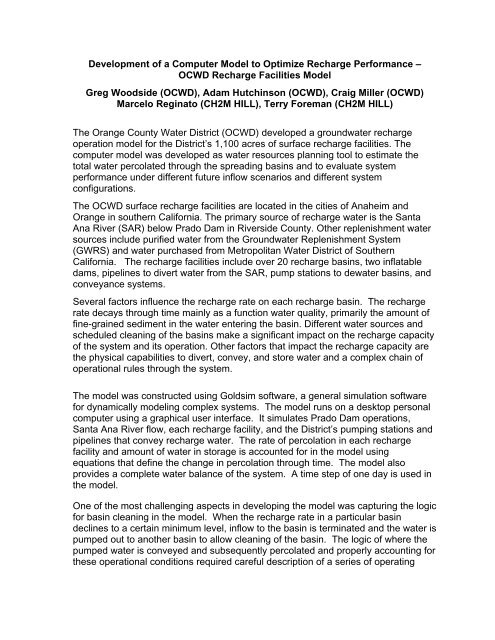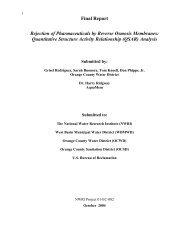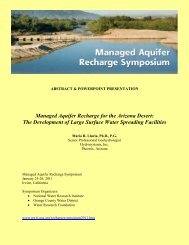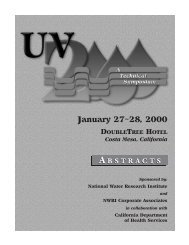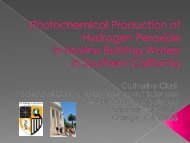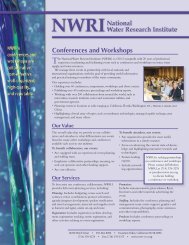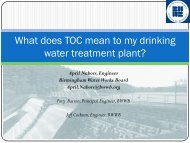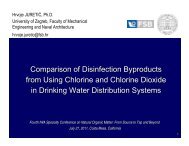Development of a Computer Model to Optimize Recharge ...
Development of a Computer Model to Optimize Recharge ...
Development of a Computer Model to Optimize Recharge ...
You also want an ePaper? Increase the reach of your titles
YUMPU automatically turns print PDFs into web optimized ePapers that Google loves.
<strong>Development</strong> <strong>of</strong> a <strong>Computer</strong> <strong>Model</strong> <strong>to</strong> <strong>Optimize</strong> <strong>Recharge</strong> Performance –<br />
OCWD <strong>Recharge</strong> Facilities <strong>Model</strong><br />
Greg Woodside (OCWD), Adam Hutchinson (OCWD), Craig Miller (OCWD)<br />
Marcelo Regina<strong>to</strong> (CH2M HILL), Terry Foreman (CH2M HILL)<br />
The Orange County Water District (OCWD) developed a groundwater recharge<br />
operation model for the District’s 1,100 acres <strong>of</strong> surface recharge facilities. The<br />
computer model was developed as water resources planning <strong>to</strong>ol <strong>to</strong> estimate the<br />
<strong>to</strong>tal water percolated through the spreading basins and <strong>to</strong> evaluate system<br />
performance under different future inflow scenarios and different system<br />
configurations.<br />
The OCWD surface recharge facilities are located in the cities <strong>of</strong> Anaheim and<br />
Orange in southern California. The primary source <strong>of</strong> recharge water is the Santa<br />
Ana River (SAR) below Prado Dam in Riverside County. Other replenishment water<br />
sources include purified water from the Groundwater Replenishment System<br />
(GWRS) and water purchased from Metropolitan Water District <strong>of</strong> Southern<br />
California. The recharge facilities include over 20 recharge basins, two inflatable<br />
dams, pipelines <strong>to</strong> divert water from the SAR, pump stations <strong>to</strong> dewater basins, and<br />
conveyance systems.<br />
Several fac<strong>to</strong>rs influence the recharge rate on each recharge basin. The recharge<br />
rate decays through time mainly as a function water quality, primarily the amount <strong>of</strong><br />
fine-grained sediment in the water entering the basin. Different water sources and<br />
scheduled cleaning <strong>of</strong> the basins make a significant impact on the recharge capacity<br />
<strong>of</strong> the system and its operation. Other fac<strong>to</strong>rs that impact the recharge capacity are<br />
the physical capabilities <strong>to</strong> divert, convey, and s<strong>to</strong>re water and a complex chain <strong>of</strong><br />
operational rules through the system.<br />
The model was constructed using Goldsim s<strong>of</strong>tware, a general simulation s<strong>of</strong>tware<br />
for dynamically modeling complex systems. The model runs on a desk<strong>to</strong>p personal<br />
computer using a graphical user interface. It simulates Prado Dam operations,<br />
Santa Ana River flow, each recharge facility, and the District’s pumping stations and<br />
pipelines that convey recharge water. The rate <strong>of</strong> percolation in each recharge<br />
facility and amount <strong>of</strong> water in s<strong>to</strong>rage is accounted for in the model using<br />
equations that define the change in percolation through time. The model also<br />
provides a complete water balance <strong>of</strong> the system. A time step <strong>of</strong> one day is used in<br />
the model.<br />
One <strong>of</strong> the most challenging aspects in developing the model was capturing the logic<br />
for basin cleaning in the model. When the recharge rate in a particular basin<br />
declines <strong>to</strong> a certain minimum level, inflow <strong>to</strong> the basin is terminated and the water is<br />
pumped out <strong>to</strong> another basin <strong>to</strong> allow cleaning <strong>of</strong> the basin. The logic <strong>of</strong> where the<br />
pumped water is conveyed and subsequently percolated and properly accounting for<br />
these operational conditions required careful description <strong>of</strong> a series <strong>of</strong> operating


